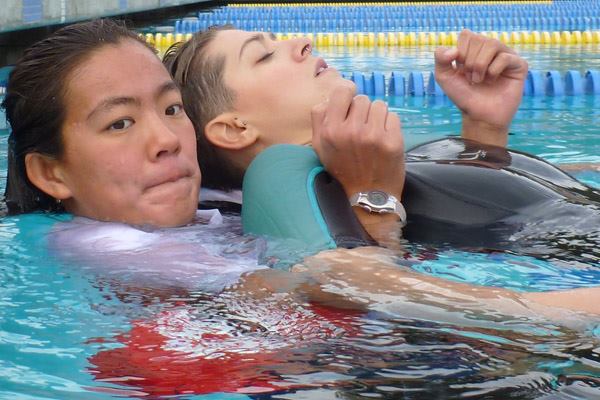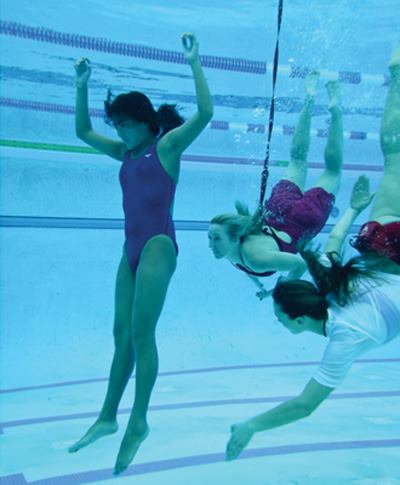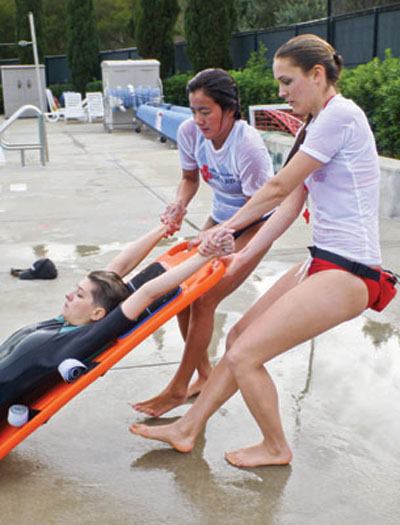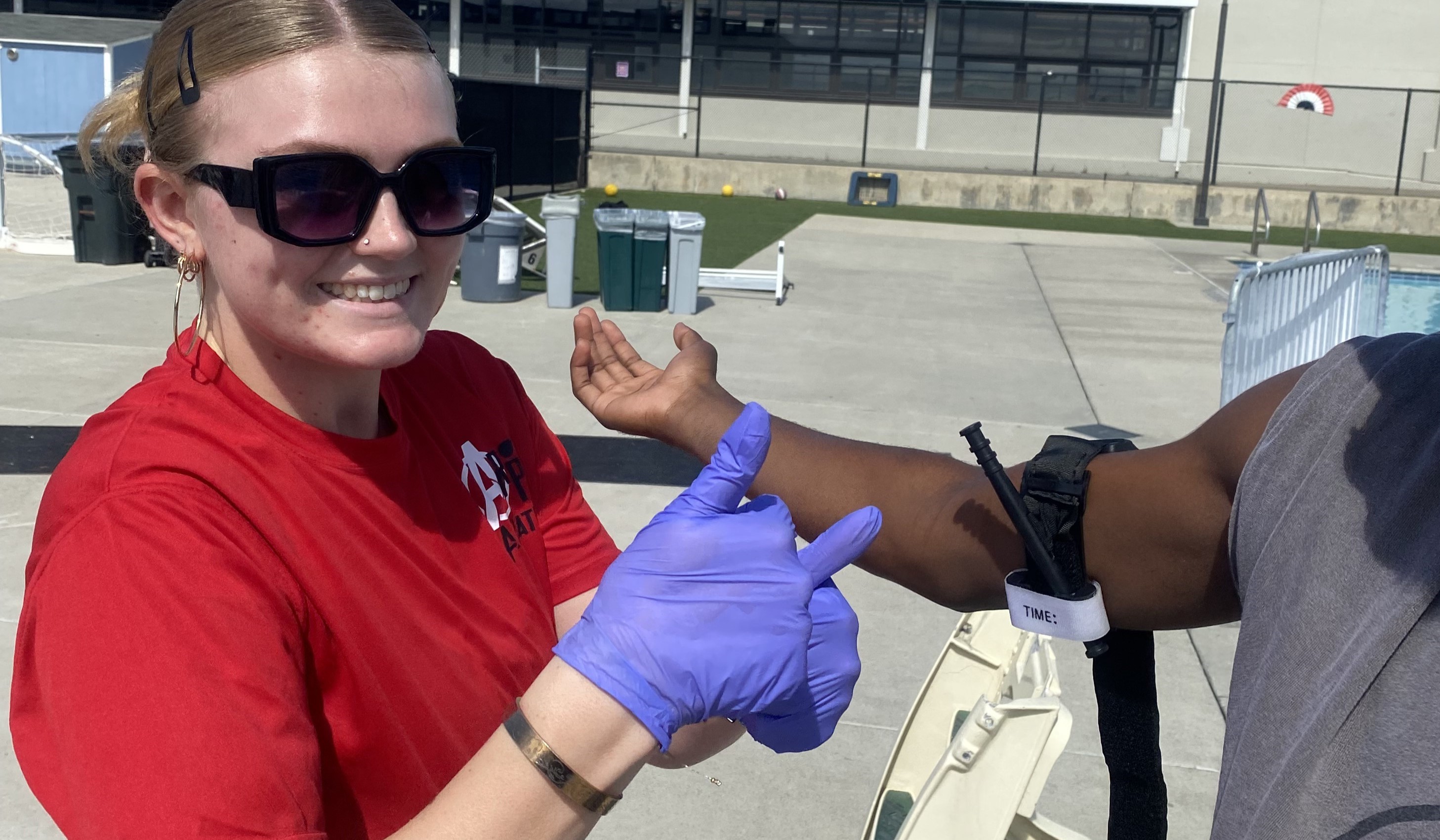Sometimes the challenge is for one lifeguard to tow another, pre…
In all incidents, whether critical or non-emergency, the victim must be moved from the area of danger. This process is known as extrication.
Whether it’s moving a submerged victim from the bottom of the pool, towing from the point of rescue to the wall, or expediting from water to land, extrication is an essential skill all lifeguards perform.
The drills here focus on team extrication for incidents where the victim is unconscious and in need of immediate care.
KICKBACK DRILL
Pair up your lifeguards on the side of the pool, one as rescuer and one as victim. The victim will be on the rescue tube, presenting as unconscious.
Objective: Rescuers must tow their victim across the width of the pool and back as quickly and safely as possible.
Timing goal: 20-60 seconds, depending on the width of the pool.
Towing a victim in water is challenging, especially if he or she is unconscious. Often lifeguards hold the victim’s shoulders under the armpits with two hands. This hold only allows the guard to do a flutter, inverted breaststroke or an eggbeater kick to move the victim to safety. Consider using a one-arm hold whenever possible, or utilizing multiple rescuers.
Repeat this drill using three different kicks: flutter, inverted breaststroke or eggbeater. This will help each lifeguard determine which is most effective and quickest.
TEAM TOW
This drill focuses on two or more lifeguards working together to move a victim.
Start in the shallow end, where the water is waist deep. Group the guards into pods of three, with one victim and two rescuers positioned on opposite sides of the victim’s shoulders.
Have the rescuers reach over the victim’s shoulders, grasping the rescue tube and pinching the arm between the rescuer’s body and the tube. Rescuers should face each other, standing ready.
Objective: Move the victim across to the other side of the pool as quickly and safely as possible.
Timing goal: 15-30 seconds.
The lifeguards will quickly find that running/wading through the water is difficult. Repeat this drill until all the pods complete the objective within the designated time. Once achieved, switch roles, so that each lifeguard gets to be a rescuer.
Variations of the team towing drill
> Mid-depth towing, water level is neck deep or slightly higher (add up to 10 seconds)
> Deep water towing (add up to 10 seconds)
> 3-on-1 rescuer towing (no time added)
Two-Person removal with a backboard procedure review: Two-person removal from the water with a backboard is one of the main ways guards extricate nonspinal victims from the water. But often it is not practiced enough.
Extrication from the water with a backboard is a complex skill. Here are 11 common errors that occur:
> Poor communication regarding which side of the rescuer the backboard should be placed
> Lack of consistent arm crossing by the rescuer holding the victim
> Backboard is not slid down along the side of the wall
> Backboard is allowed to list to one side during placement of the victim
> Failure of the rescuer to use their foot to stabilize the backboard
> Unequal holds by rescuers when pulling the backboard and victim from the water
>Too steep an angle on the backboard when pulling it from the water
>Dropping, rather than lowering, the backboard down on land
> Not having a clear runway for the backboard to be placed
> Only practicing victim removal on in-service training days focusing on spinal emergencies
> Second rescuer not removing the rescue tube strap upon exiting the water
Before starting the extrication drill, break lifeguards into pods of three (two rescuers and a victim), and have them review two-person removal for at least 10 minutes, repeating the procedure until none of the mistakes listed earlier occur.
Decide which side the backboard should be placed on the rescuer at your facility, and make that a standard. This will help expedite the victim removal, eliminate the delay caused by the rescuers deciding, and synchronize the staff.
Remember, this will dictate how the deck rescuer will cross their arms while holding the victim (the top hand needs to be on the side of the backboard).
EXTRICATION DRILL
Start with the primary rescuer on the side of the pool with the victim, and the secondary rescuer on the deck with the backboard.
Objective: Have the victim on the deck using the two-person removal with a backboard technique as quickly and safely as possible.
Timing goal: 20 seconds to achieve the objective.
Move to the variations once the entire group has accomplished the timing goal, with every lifeguard getting to participate in the different rescuer positions.
Variations of the extrication drill
> Same drill with timing goals of 15 seconds
> Rescuer and victim 10 feet away from side of the pool (20 seconds)
> Backboard 30 feet away (20 seconds)
> Both rescuers in the water with victim at the side of the pool, backboard 30 feet away (25 seconds)
> Both rescuers in the water with victim 10 feet away from side of pool, backboard 30 feet away (30 seconds)
> Same drill ending with rescuers on deck with gloves on (20 seconds)
> Same drill starting with equipment in its usual location and secondary rescuer in a lifeguard chair or other station (30 seconds)
> Same drill ending with rescuers and victim on deck, primary assessment done, rescue breathing in process, having delivered three rescue breaths to complete the objective (40 seconds)
DEEP-WATER SUBMERGED EXTRICATION DRILL
Requires two rescuers and one victim. Victim will be submerged on the bottom.
Both rescuers will retrieve the victim. Primary rescuer will grasp victim from behind while secondary rescuer will plant their feet firmly on the bottom and grasp the primary rescuer.
The objective of the secondary rescuer is to give the primary rescuer and victim a boost to the surface.
Objective: Get the victim and rescuers to the surface quickly and safely.
Timing goal: 10 seconds to finish objective.
Remember: Extrication is a team effort that requires constant training. It is rare that EMS, police or fire personnel will get in the water to assist a lifeguard in extricating a victim due to the demands of the critical incident.
Getting the victim into EMS or fire hands quickly depends on you and your lifeguard staff. Train hard, and train often.




